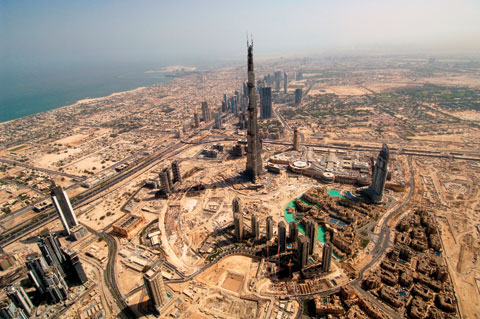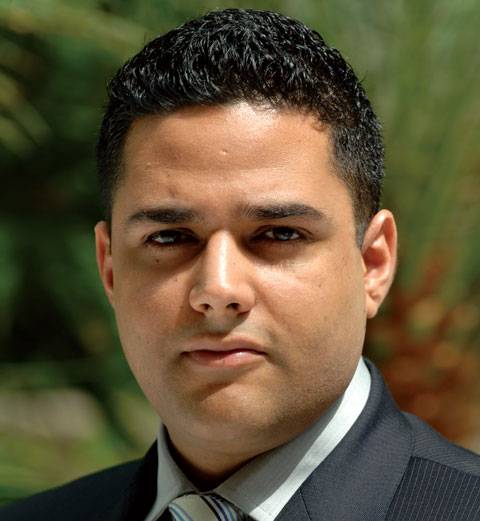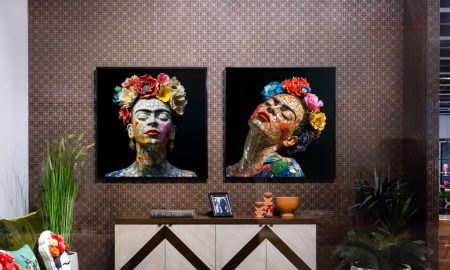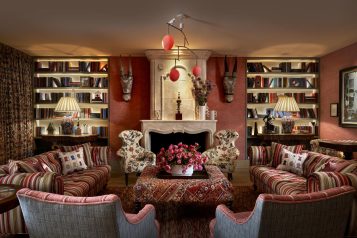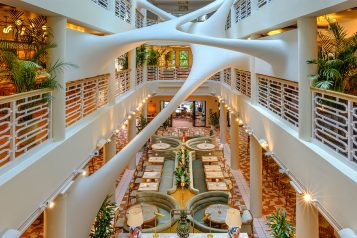In the last 10 years the city of Dubai has exponentially developed from a deserted desert town to an ambitious, thriving city that is expanding at supercollider rates of bigger and faster. Dubai has already surpassed Cairo as a tourist destination. By 2010, Dubai expects 15 million visitors a year, and it’s building to accommodate that number. So while Cairo has the original pyramids, Dubai is the epicenter for the new-age ones, the ones that are blurring the lines between architectural fantasy and reality. And nothing symbolizes this quantum leap from impossible to probable better than the world’s largest building, the Burj Dubai. Although not yet completed, the tower reached more than 2063.6 feet on April 7, 2008, becoming the highest structure ever built by humans.
The Burj (“tower” in Arabic) is a cosmic pillar that defies belief, as its slender stacks gently curve towards the heavens. Inside, it looks like a set from Blade Runner or the interior of the Death Star from Star Wars. Although its ultimate altitude remains a secret, the spire that stretches above its 160 stories of apartments and office suites will climb to at least the almost unimaginable half-mile height of 2684 feet-it’s like putting an Empire State Building on top of…another Empire State Building.
Therefore, Burj Dubai doesn’t just surpass Taiwan’s 1671-foot Taipei 101 (the previous record holder), it crushes it. Upon completion, the Burj Dubai will be the tallest building in the world in all four categories recognized by the Council on Tall Buildings and Urban Habitat, which compiles and ranks the world’s tallest buildings. CTBUH ranks buildings on the basis of spire height, the highest occupied floor, roof height, and pinnacle height.
Thus, the Burj, with its undeniable wow-factor, also reflects the new geographies of the skyscraper (even skyscraper is old school; the new word: supertall), shifting from the United States to Asia and the Middle East. The ambition to erect the world’s tallest tower is as old as the ages, and like the pyramids or gothic cathedrals, the Burj is an architectural and engineering marvel of its time.
The iconic Burj will be principally a residential tower, with a Giorgio Armani-designed and managed hotel at the base, luxury residential apartments serviced by the hotel, private residences, and 37 corporate suit.
It’s the new paradigm for the 21st century supertall. Until the 1990s, the tallest scrapers were almost always giant office buildings, made of steel, and erected in the New World (think: Sears Tower and Chrysler Building). Today, they are principally residential or mixed-use buildings, made of concrete or composite and located back in the Old World. It’s a shift that represents those regions’ expanding economies, profound wealth, aggressive real estate investment, and desire to compete at the highest level for international status and business.
The tower is the centerpiece of a 500-acre, $20 billion mega-complex known as Downtown Burj Dubai, developed by Emaar Properties PJSC, one of the world’s largest publicly-traded real estate companies. A project of superlatives, Downtown Burj Dubai will feature the world’s tallest tower, one of the world’s largest shopping destinations, a lagoon, landscaped parks and gardens, and a range of neighborhoods of new high-rise housing and traditional villas, including an “Old Town.”
On March 9, 2003, Emaar invited Skidmore, Owings & Merrill’s Chicago office, along with four other prominent international architectural firms, to compete for the commission to design a tower they intended to be the world’s tallest building. Within a few weeks, SOM was chosen. As George Efstathiou, managing partner of SOM, recounts, “I’ve seen a lot of clients dreaming of building a supertall. Not many come to fruition, because you really have to know what you’re doing. You have to have the financial wherewithal. You have to have the guts. The recipe is very complex. Everything has to be in place. Otherwise it’s all talk.”
Founded in 1936, SOM’s sophistication in building technology applications and commitment to design quality has resulted in a portfolio that features some of the most important architectural accomplishments of the 20th century. Examples include the Sears Tower and John Hancock Center in Chicago; Jin Mao Tower in Shanghai; and Canary Wharf in London. But first, SOM had to put together a team unprecedented in size and scope. “The logistics of organizing a team of 90 people has been a major feat in and of itself,” Efstathiou chuckles.
In order to conquer the challenges posed by jaw-dropping height, SOM rewrote the book. The design of Burj Dubai derived from the patterning systems embodied in Islamic architecture, with the triple-lobed footprint of the building based on an abstracted desert flower native to the region, the Hymenocallis. It’s ironic that a delicate flower inspired a building with a curtain wall that will be as long as 17 soccer fields (or 25 football fields).
The problem with most ambitious architectural endeavors is that people can’t figure out the right way to construct them after the design. SOM, however, posed new structural approaches rather than reworking old ones, and thus brewed up the perfect blend to erect the Burj: a buttressed core. Three structural “wings” extend out of a central hub to create a Y-shaped floor plan. The wings provide support for the building, and the core keeps the wings firmly anchored so they don’t twist in the wind, the bane of all supertall dreams.
Tall buildings must resist overturning due to lateral forces from wind, earthquakes, or even their own weight. Beyond insuring against catastrophic failure, engineers and architects must design structures that do not flex too much, since movement can damage joints, cause leaks, and even break windows and façade panels. Inside, excessive movement can also jostle or jam elevators, crack walls, and cause unnerving creaks and groans. Many people are sensitive to even slight motion in buildings. So the building was engineered to confuse the wind, as its constantly changing shape diminishes wind forces that normally accumulate around a huge building.
It allowed the Burj to go up tall, fast, and with enough usable floor space to maximize Emaar’s profits. As the tower rises from the flat desert base, setbacks occur at each element in an upward spiraling pattern, decreasing the mass of the tower, and getting step-by-step slimmer as it reaches toward the sky. At the top, the central core emerges and is sculpted to form a finishing spire.
The building also has a system to control pressure for when you get higher up, as well as a system to control pressure as you ascend in the elevators. Another interesting architectural feat to note is that the building itself is all curved-there are no right angles in the outer perimeter of it.
As mentioned, the iconic Burj will be principally a residential tower, with a Giorgio Armani-designed and managed hotel at the base, luxury residential apartments serviced by the hotel, private residences, and 37 corporate suites. Amenities include: a cigar club, four pools, restaurants, library, an observation platform at a breathtaking 1450 feet, exclusive residents’ lounge, a 15,000-square-foot fitness area, four communications floors, 52 elevators, and 3,000 parking spots. As proof of the Burj’s magnetism, the apartments sold out in the first three days that they were made available.
When it opens in September 2009 and the closely guarded final height is finally revealed, Burj Dubai will be a once-in-a-world palace of glass, with floor-to-ceiling windows. The glitter of the façade will not only represent the glamour inside, it will also reflect the latest shining accomplishment of mankind. And though it will be called many names, only a privileged few will call it home.







